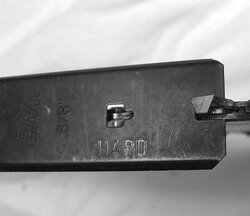A few weeks ago I decided that my chain (the original that came with the saw) had been sharpened enough times, plus I wanted another so I would not have downtime. So I purchased a replacement chain for my Husky 136 (Their bottom end consumer saw) Since at the same time I had the old chain sharpened, I hadn't put the new one on. I did notice that the new chain looked a little different in that the little depth restrictors seemed, well....just different. I put the chain on yesterday after I touched the dirt and killed the old chain's edge. WOW....The saw NEVER cut this well. I had always been sort of dissapointed in the cutting performance of the saw compared to my fathers REALLY old homelite. I attributed the issue to the chain being a safety chain. The new chain us supposed to meet the specks for a replacement chain, but there is no way it's the same animal. Cutting a peice of 12" oak I know this weekend, I know the old chain would take 30-40 seconds...now like 15 seconds. The saw bogs down a lot less and now I can just rely on the saw weight to move through the wood. I cut down and cut up a whole tree that was 12 inches across in about 1/2 hour. I hope this chaing doesn't kill my clutch, but I might not care.
So if your saw isn't performing well, maybe it's your chain. I was thinking I needed a new saw...not any more!!
So if your saw isn't performing well, maybe it's your chain. I was thinking I needed a new saw...not any more!!


 I have to buy a file. The place I go for sharpening charges liek 8 buck to sharpen, plus they carve out so much of the teeth I only had it sharpened twice and I think the chain is close to being toast. The other annoying thing is that once they sharpened it the saw would always cut a slight arc. The new chain cuts perfectly straight through the log.
I have to buy a file. The place I go for sharpening charges liek 8 buck to sharpen, plus they carve out so much of the teeth I only had it sharpened twice and I think the chain is close to being toast. The other annoying thing is that once they sharpened it the saw would always cut a slight arc. The new chain cuts perfectly straight through the log.